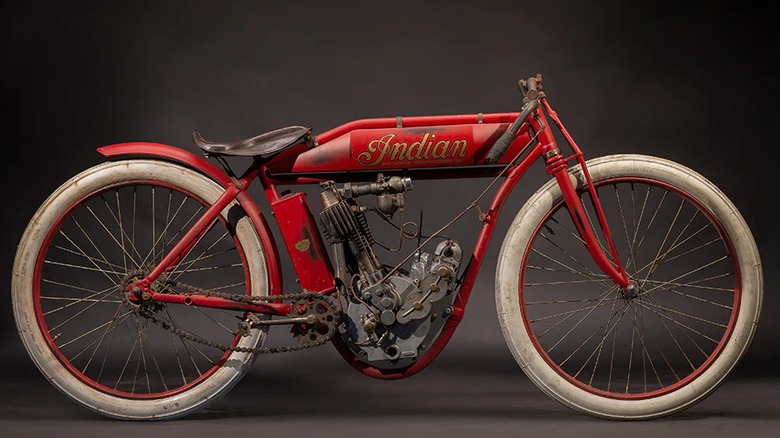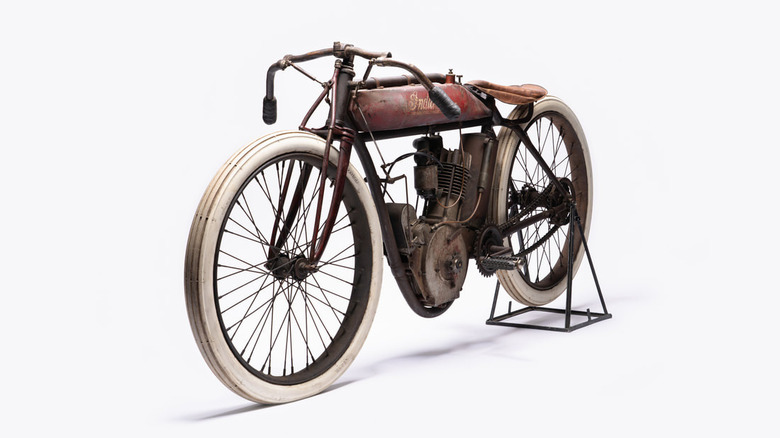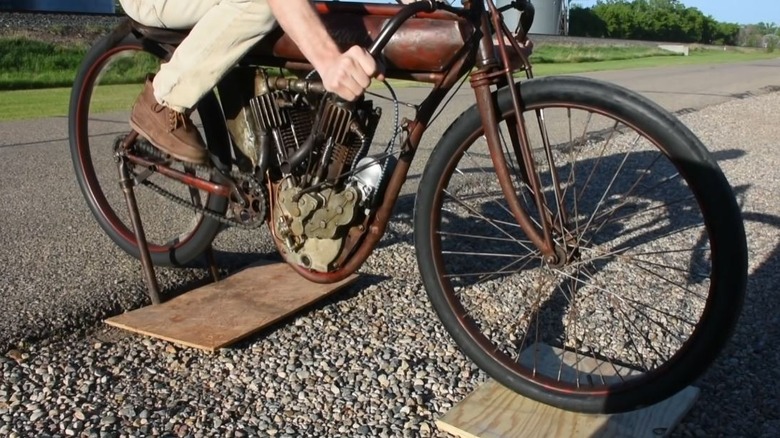What Made The Indian Board Track Racer An Important Part Of Motorcycle History
When you think of motorcycle racing, you probably think of either stadium races featuring the fastest motorcycles ever built or runs around a cordoned-off course on a commercial road. However, at one point in history, over a century ago, motorcycle racing had quite a different face. Specifically, a face made up of angled wooden planks. This was the era of board track racing, where the early motorcycles would careen around an angled wooden track at high speeds with minimal protections, kind of like a cross between a NASCAR track and a roller derby ring.
In order to handle the smooth surface and deep curves of the wooden motordrome, riders needed a particular kind of motorcycle, one that was capable of both intense speed and superior handling. The bike of choice for many of these daredevil drivers was the 1912 Indian, an early production by the motorcycle manufacturer of the same name.
The bike that ruled the motordrome
Originally founded by George Hendee as the Hendee Manufacturing Company in 1897, the company that would become Indian produced its first motorcycles in 1901. The company's first offering that year was a road-designed model with a 1.75 hp, single-cylinder engine. The first Indian was a success and bikes circulated quickly. This had an interesting side effect, however: once board track racing hit the scene in 1908, many riders used their road-made Indians in the races, albeit with some quick modifications.
In the following years, to better accommodate its newfound popularity as a board track brand, Indian began testing new motorcycle concepts built with racing in mind. The company even constructed its own motordrome in its hometown of Springfield, Massachusetts, both for testing purposes and to show off a bit. In 1912, these tests bore fruit as the first Indian Board Track Racer rolled off the lot.
Need for speed
The 1912 Indian featured a 500cc 31.5 cubic-inch single-cylinder engine, equipped with a Bosch American Magneto and Hedstrom carburetor. A second version was released later with an inlet-over-exhaust, air-cooled, F-head V-twin engine. All of this was built into a factory-made frame painted in the company's signature shade of deep red.
Since the 1912 Indian was built specifically with the racetrack in mind, it didn't have much in the way of safety features. Safety features meant less speed, and that was a no-no. The bike had no brakes or clutch, not to mention open carburetors belching fumes. Combined with the fact that the riders usually didn't wear helmets as they screamed around an angled track at over 100 MPH, it was a generally unsafe experience all around.
Safety issues would be the end of the Indian Board Racer and board racing as a sport. In September of 1912, a tragic accident claimed the life of racer Eddie Hasha and four spectators, three of them children. He had been riding an Indian 8-valve. With board racing motordromes already nicknamed "murderdromes" by the public, the accident brought an end to the sport. Indian transitioned to building the road bikes that define the brand today.
The 1912 Indian Board Track Racer may have been the definition of a deathtrap, but while it thrived it was the very image of sporting speed. The history of Indian motorcycles embraces a whole range of concepts and design specs, but it all began here.


